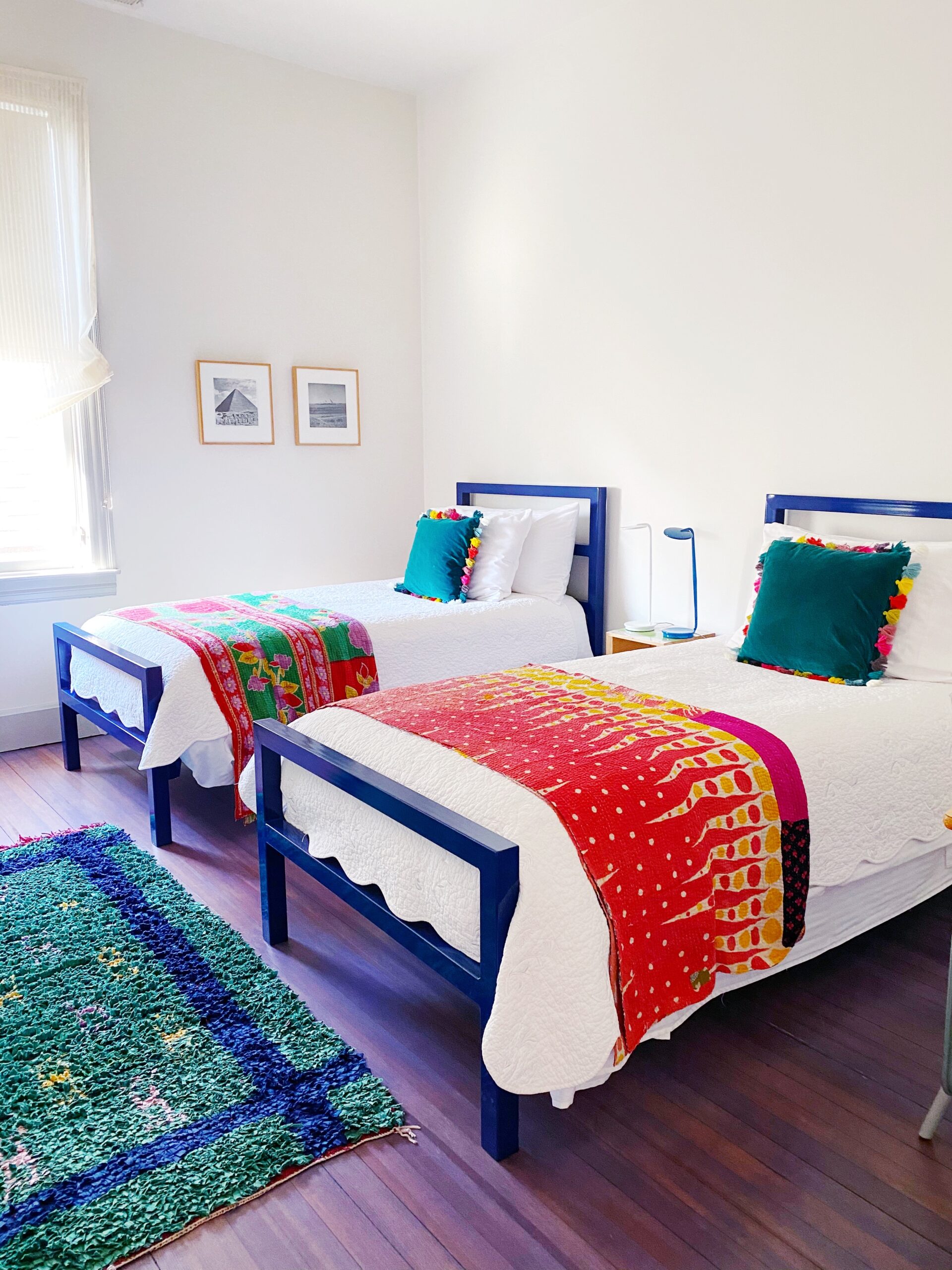How to Decorate on a Budget

A few months ago I asked on Instagram whether you feel like you don’t have the money to decorate the way you’d like to. I was pretty sure this was a common feeling, with so many expensive interiors and ads for housewares floating through our feeds on a daily basis. But even I was surprised to find that 90% of my followers feel that their desired decor is out of their budget.
I was curious if this sentiment was mostly felt by people in the lower half of the income scale, or if it was broader than that. So next, I asked: What’s your approximate household income?
Turns out that everyone up and down the income scale feels this way. For example, people making $350,000 or more are technically the 1% in the US, but they made up 7% of the people who felt design was unaffordable to them. Among people who make over $200k, there was a similar over-indexing of the feeling of not having enough money to decorate the way they wanted.
On reflection, this isn’t really surprising. The more you make, the more your friends likely make, and the more exposure you have to pricey designs. Not only that, but as income rises, the size of homes often rises as well, which means more to furnish.
The point is that in a world full of beautiful, expensive things, it can be easy to get stuck on what’s outside your budget, rather than noticing all the joyful possibilities within it.
How to Decorate on a Budget
As someone who has always been budget conscious when it comes to design, I’ve picked up a lot of tricks for stretching a budget to the maximum. In this post, I’m sharing five tips that have saved me a ton of money over the years. These tips are pulled from a special resource called The Joyful Guide to Decorating on a Budget, which includes more than 50 tips and ideas for saving money on design. (It also includes a copy of my personal budgeting template which I swear by for helping to bring a product in under budget*.*) **
This guide is available right now as a bonus when you join the Design a Home You Love course this weekend. Note that this bonus is only available until Sunday, April 21 at midnight ET, so if you’re thinking of joining the course, don’t wait!

Armed with these strategies, I often find that decorating on a budget feels like a fun challenge, rather than a stressful task. I hope they help you feel the same!
Focus on the Feeling
If you attended last week’s Feelgood Home workshop, you know that I believe in starting the design process with how you want to feel in your space. (If you missed it, there’s still one last session!) But what does the feeling of your space have to do with your budget?
Starting with the feeling is important because it opens up your options. When you start with a particular style or you’re trying to recreate an inspirational image you’ve seen, it’s easy to get attached to a particular item — a wallpaper pattern or a fancy chair — and struggle to move forward if you can’t afford it.
When you focus on the feeling of your space, you begin to understand that there’s no one perfect item that’s essential to your design. For example, let’s say you want to create a feeling of lightness. If the cloud wallpaper pattern you fell for isn’t in budget, instead of going looking for cheaper dupes that will always make you feel like you compromised, you can look for other elements that would bring lightness that are in your budget. Maybe you use a more affordable abstract wallpaper that has the same energy, or maybe you skip wallpaper altogether and put the money toward translucent curtains that create lightness.
(If you’re not sure how you want your space to feel, module 2 of Design a Home You Love breaks it all down step-by-step. Find more details on the course, which closes April 25, here.)
Avoid “Faberge Eggs” (Prioritize Your Largest Surfaces)
Somehow whenever I’m on a tight budget, I always fall in love with one teeny tiny item that’s so expensive it might as well be made of gold. Like the hand-embroidered throw pillow I wanted for Graham’s nursery, or the pricey trays I was eyeing to organize our coffee table.
I call these things Faberge eggs because they swallow up a ton of your budget but are visually too small to make much of an impact on the design of your space. Whenever I end up buying one, even if I love it, I’m always disappointed by how little the overall space changes.
When you’re working with a tight budget, my recommendation is to always look at your largest surfaces first, because these are the ones that are going to create the biggest transformation. So that means upholstery, rugs or flooring, walls, large-scale pieces of art, and tables — all of these things will give you a lot of value in terms of how much they will change your daily experience of the space. Meanwhile, throw pillows, knick knacks, small art pieces, table lamps: be careful of investing too much money here until you’re happy with the overall energy in the space.
Plan for Sales
I didn’t realize until I’d furnished a few different homes that there’s a fairly predictable sales cycle in the home furnishings world. In the US, President’s Day and Labor Day are two big ones, with many mass merchandisers offering 15%-25% off everything in the store. Black Friday and Cyber Monday are also a chance to scoop up items for your home at a bargain. Some stores also have regular Friends and Family sales that occur at the same time each year. If there’s a merchant you’re curious about, just try googling their name and “friends and family sale” and you can often find a blogger who has that info.
It’s also worth noting that some items go on sale in a seasonal cycle. For example, outdoor furniture is most expensive in late winter and early spring, and cheapest in late summer and fall.
Planning for sales might add a bit of wait time to your process, but it can be worth it if you’re not in a rush as it allows you to stretch your budget in other places.
Upgrade Off-the-Shelf or Vintage Items
There’s something so satisfying to me about taking an ordinary IKEA cabinet or sad bench from the corner of a thrift shop and upcycling it with unique components. Not only is it a huge savings over most mid-priced furnishings, it’s also exciting to have something totally unique for your space.
My way of approaching this is to look at the form I want and then deconstruct how to get there. For example, in my office, I knew I wanted a low cabinet to tuck supplies out of sight. I ordered some IKEA Besta units, then bought some doors to fit from Semihandmade in a simple Shaker style. I’ll paint these (currently thinking yellow), add turned legs ordered off of Etsy, and splurge a little on fancy knobs to give the thing a custom look.
As I was assembling this cabinet, I realized that if I separated the units and put a piece of wood across the top, I could create a kind of mini desk, which would add another work surface to my office. So I ordered a sheet of fine-grade birch plywood and got my handyman to cut it to size for me. The whole thing was far less expensive than buying a pre-made cabinet (much less a custom one!), and when finished, it will add a pop of personality I’d never find in a store.
Match Trends to Lifespan
One of the biggest challenges I hear about in decorating is figuring out how to navigate trends. On one hand, it’s easy to say: “Avoid trends! Only buy classics!” On the other, sometimes a trend genuinely appeals to you and it brings a sense of fun and liveliness to your space.
My take is this: trends are fine when you apply them to shorter-lifespan items. So when you’re thinking about a purchase, first look at how long you plan to keep the item. If it’s a table or a dresser, you could easily have that in your home for 20 years or more. So you’ll get the best value by keeping it classic.
On the other hand, if you’re buying bed or table linens, slipcovers, lampshades, rugs in high-traffic areas — these are a perfect opportunity to go for a fun trend. If you love it, you’ll get a lot of joy from it while you have it, and you won’t be so sad when it’s worn out and time for a replacement.
—
I hope these ideas help you squeeze more decorating joy out of your budget, and inspire you to feel creative rather than constrained.
You can find 50 more ideas and tips for cost-conscious decor in The Joyful Guide to Decorating on a Budget, which you’ll receive as a bonus when you join the Design a Home You Love course. This bonus is only available until Sunday, April 21, so if you’re planning to join us, don’t wait too long to sign up.




Leave a Comment